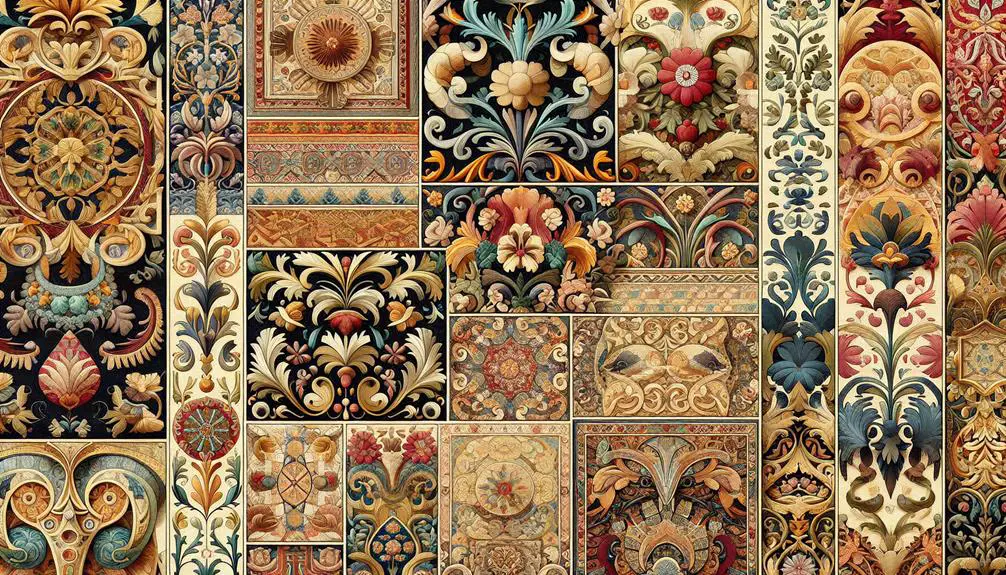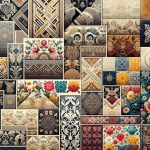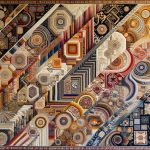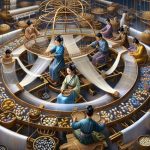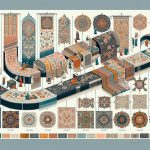As you explore the historical evolution of textile patterns, you'll find a fascinating journey that spans millennia and continents. Imagine ancient weavers in Egypt crafting intricate patterns with rudimentary looms, each design holding symbolic meaning. Fast forward to the bustling Silk Road, where cultural exchanges injected vibrant motifs into textiles that traveled vast distances. The Industrial Revolution then transformed the landscape with mechanized looms, making patterns more accessible than ever before. Yet, how did these innovations influence the fabric of modern society, and what stories do today's textiles continue to weave?
Table of Contents
Key Takeaways
- Ancient civilizations perfected weaving principles, creating intricate textile patterns with cultural symbols and historical events.
- Medieval and Renaissance textiles featured religious themes and storytelling, enriched by cross-cultural influences through trade routes.
- Asian textiles along the Silk Road incorporated floral motifs, geometric designs, and animal symbols, reflecting cultural exchanges and artistic influences.
- The Industrial Revolution introduced mechanized looms and chemical dyes, enabling mass production and expanding the color palette for textiles.
- Modern textile patterns blend traditional motifs with digital tools, focusing on sustainability and democratizing design access.
Ancient Weaving Techniques
Ancient weaving techniques, developed over millennia, showcase humanity's ingenuity in crafting intricate textile patterns. By understanding these methods, you can appreciate how advanced loom technology and ancient tapestries have influenced modern textile artistry.
To master these techniques, you need to explore the fundamental principles of weaving that ancient civilizations perfected.
Loom technology was essential in transforming raw fibers into elaborate fabrics. Early looms, though primitive by today's standards, were marvels of engineering. They required skill and precision, using tension to interlace threads systematically. You'd find that artisans employed vertical and horizontal looms, each suited to different types of textiles and patterns. Mastering these tools allowed weavers to create complex designs that weren't only beautiful but also structurally sound.
Ancient tapestries are a demonstration of this mastery. They weren't just decorative; they told stories, depicted historical events, and displayed cultural symbols. By studying these tapestries, you can learn the nuances of color blending, texture creation, and pattern repetition.
This knowledge is essential if you aim to replicate or innovate upon these ancient designs. Understanding and applying these ancient techniques will surely elevate your weaving skills to an expert level.
Patterns of Ancient Egypt
Egypt's rich tapestry of textile patterns offers a glimpse into a civilization that valued artistry and symbolism in every woven thread. As you explore the fabrics of Ancient Egypt, you'll discover an array of hieroglyphic motifs that weren't merely decorative but also imbued with symbolic meanings.
These motifs often depicted gods, goddesses, and sacred animals, serving as talismans or conveyers of divine protection.
When examining the textiles worn by the Pharaohs, you'll notice an unparalleled level of luxury. The Pharaohs' clothing was crafted from the finest linen, adorned with intricate patterns that signified their divine status and royal lineage.
These luxury textiles were often dyed in vibrant colors and embellished with precious stones and gold threads, making each garment a masterpiece of both craftsmanship and symbolic expression.
Understanding these patterns gives you a deeper appreciation for how textiles were integral to Egyptian culture, not just as functional items but as carriers of profound symbolic meanings.
The meticulous attention to detail in each piece reflects a society where artistry and symbolism were seamlessly woven into the fabric of daily life, elevating their textiles to a form of high art.
Roman and Byzantine Influence
The textile patterns of the Roman and Byzantine eras reveal a captivating blend of cultural influences and sophisticated design techniques. As you explore Roman textiles, you'll observe how Roman mosaics profoundly influenced the patterns woven into fabrics. These intricate designs often featured geometric shapes, mythological scenes, and nature motifs, all meticulously crafted to reflect the grandeur of Roman artistry.
Transitioning into the Byzantine period, you'll find that textile patterns took on even more intricate and luxurious characteristics. Byzantine tapestries exemplify this evolution, showcasing elaborate designs that incorporated religious iconography, imperial symbols, and complex floral motifs. These tapestries weren't just decorative but also conveyed a narrative, often telling stories of saints, emperors, and significant historical events.
In both Roman and Byzantine textiles, the use of rich colors and precious materials like gold and silver threads signified wealth and status. The cross-cultural interactions of these eras are evident in the patterns, borrowing elements from Persian, Egyptian, and even Far Eastern designs. By comprehending these influences, you gain a deeper appreciation of the historical and cultural significance embedded within each textile pattern of these remarkable periods.
Medieval European Textiles
Shifting from the opulent Byzantine textiles, you'll now explore how medieval European patterns were shaped by feudal society, religious fervor, and burgeoning trade routes.
Medieval tapestries served not just as decorative pieces but as storytelling mediums, illustrating biblical tales, historical events, and legends with intricate designs. These tapestries, often seen as grandiose wall hangings in castles and cathedrals, showcased the era's artistic and technical prowess.
The craftsmanship excellence of European textile techniques during this period was unmatched. Weavers employed a variety of materials, including wool, silk, and linen, to create detailed and vibrant patterns. Techniques such as brocade, embroidery, and weaving with gold and silver threads demonstrated their skill and innovation. Each piece was a tribute to the meticulous labor and creativity that defined medieval artistry.
As you explore further, you'll notice the influence of religious themes, reflecting the central role of the Church in everyday life. The proliferation of trade routes allowed for the exchange of ideas and materials, enriching these designs further. By mastering the understanding of medieval European textiles, you gain insight into a world where art, religion, and society were intricately intertwined.
Asian Silk Road Patterns
Driven by the extensive network of trade routes, Asian Silk Road patterns mirror a rich tapestry of cultural exchanges and artistic influences. As you explore these intricate designs, you'll uncover a world where traditional motifs carry deep cultural significance and serve as proof of the vibrant cross-cultural exchange that occurred along the Silk Road.
To appreciate these patterns fully, consider the following:
- Floral Motifs: Flowers like lotuses and chrysanthemums symbolize purity and renewal, often found in Chinese and Persian textiles.
- Geometric Designs: Central Asian textiles showcase intricate geometric patterns, reflecting the mathematical progress and artistic accuracy of the region.
- Animal Symbols: Dragons, phoenixes, and other legendary creatures in Chinese and Persian designs represent strength, wisdom, and safeguarding.
- Calligraphy: Islamic textiles frequently display detailed calligraphy, blending art and writing to convey spiritual and cultural messages.
Renaissance Textile Innovations
During the Renaissance, textile innovations flourished, blending artistry and technology in ways that revolutionized fashion and interior design. You'd find textile craftsmanship reaching unparalleled heights as artisans began to experiment with intricate weaving techniques and vibrant dyes. They drew artistic inspiration from classical antiquity, nature, and burgeoning scientific discoveries, resulting in fabrics that were as visually stunning as they were technically advanced.
Imagine walking into a Renaissance court, where rich brocades and velvets adorned the nobility. The textiles weren't just about luxury but also a statement of power and sophistication. Craftsmen meticulously hand-wove patterns that told stories, incorporating motifs like floral designs, mythological scenes, and geometric shapes. These patterns weren't arbitrary; they were carefully chosen to reflect the wearer's status and intellect.
The introduction of new materials like silk and advancements in loom technology allowed for more complex and durable fabrics. You'd see how the mastery of textile craftsmanship turned simple cloth into works of art that played an essential role in the culture and economy of the time. This era set the stage for future innovations, weaving a legacy of creativity that continues to inspire.
Industrial Revolution Changes
The Industrial Revolution transformed textile production, making fabrics more accessible and affordable through the use of mechanized looms and innovative manufacturing processes. You witnessed an era where the mechanization impact was profound, revolutionizing how textiles were made. Factories sprang up, facilitating mass production and driving down costs.
This period marked a significant shift in textile patterns, thanks to advancements such as:
- Mechanized Looms: These allowed for intricate designs to be produced quickly and consistently, which was previously unattainable.
- Roller Printing: Introduced in the late 18th century, it enabled faster and more efficient pattern printing on fabrics.
- Factory Production: Centralized production meant standardization and quality control, ensuring uniform textiles.
- Chemical Dyes: Synthetic dyes replaced natural ones, allowing for a broader color palette and more vibrant patterns.
With these innovations, you gained the ability to produce textiles on an unprecedented scale. This shift not only democratized fashion but also set the stage for variety in textile patterns. By understanding the mechanization impact and the rise of factory production, you can appreciate how these changes laid the groundwork for modern textiles.
Digital Era Designs
In the Digital Era, technological advancements revolutionize textile patterns, making intricate designs more accessible.
Contemporary trends now reflect a blend of tradition and innovation, driven by digital tools.
You can explore how these technologies impact both the creation and consumption of modern textile designs.
Technological Advancements Impact
Advances in digital technology have revolutionized textile pattern design, enabling intricate and personalized creations like never before. Automation impacts traditional techniques by streamlining processes that once required meticulous handwork. This shift not only accelerates production but also allows for complex patterns with unparalleled precision.
However, you should be mindful of sustainability concerns associated with modern production. The rapid pace of digital manufacturing can lead to excessive waste if not managed responsibly.
To fully appreciate how technological advancements have transformed textile patterns, consider these key points:
- Precision and Customization: Digital tools enable you to create detailed and unique designs tailored to specific needs, something that was almost impossible with traditional methods.
- Efficiency: Automation allows for faster production cycles, reducing the time from concept to final product.
- Sustainable Options: Modern technology offers eco-friendly materials and processes, helping to address sustainability concerns.
- Accessibility: Advanced software democratizes design, allowing even novice designers to experiment with complex patterns.
Contemporary Pattern Trends
As you explore contemporary pattern trends, you'll notice how digital era designs are pushing the boundaries of creativity and innovation. Advanced software and digital printing technologies allow designers to experiment with intricate, previously impossible patterns. Modern interpretations of traditional motifs are seamlessly blended with cultural influences, creating unique, globally-inspired textiles.
One significant trend is the rise of sustainability in textile design. You'll find a growing emphasis on eco-friendly textiles, with designers opting for organic, recycled, and biodegradable materials. Digital printing itself is more sustainable than traditional methods, using less water and energy, and producing minimal waste. This shift not only meets consumer demand but also aligns with broader environmental goals.
Moreover, the digital era has democratized design. You can now access a plethora of design tools online, enabling independent designers to create and share their patterns effortlessly. This fosters a diverse, inclusive design community where innovation thrives.
You'll see patterns that aren't just visually stunning but also tell stories, reflect identities, and honor traditions. By embracing both modern interpretations and cultural influences, today's textile patterns are more dynamic and meaningful than ever before.
Frequently Asked Questions
How Did Indigenous Cultures Influence Global Textile Patterns?
You'll see how indigenous influences shaped textile patterns worldwide by creating global connections. Imagine ancient Pinterest boards showcasing vibrant designs. These patterns, rich in cultural heritage, have inspired modern fashion and interior design trends globally.
What Role Did Textiles Play in Ancient Trade Routes?
You need to understand that textiles were pivotal in ancient trade routes. They were highly coveted on the Silk Road and other trade networks, facilitating cultural exchange and economic growth across vast regions.
How Do Cultural Beliefs Shape Textile Patterns?
You'll notice cultural influences and traditional symbolism directly shape textile patterns. By understanding a culture's values and beliefs, you can see how they're woven into the fabric, creating unique designs that tell a distinctive story.
What Are the Environmental Impacts of Textile Production?
When examining the environmental impacts of textile production, you'll find it greatly increases the carbon footprint and water usage. To master sustainability, focus on reducing these factors through eco-friendly materials and efficient processes.
How Have Modern Technologies Improved Textile Sustainability?
Investigate the truth of a theory: modern technologies have indeed revolutionized textile sustainability. You'll find eco-friendly innovations and sustainable practices now dominate the industry, greatly reducing waste and conserving resources, making it more sustainable than ever.
- How Does Ring Spun Cotton Affect Garment Fit and Shape Retention? - August 13, 2024
- What Are the Challenges in Producing Ring Spun Cotton? - August 13, 2024
- Is Ring Spun Cotton Suitable for Plus-Size Clothing? - August 13, 2024

